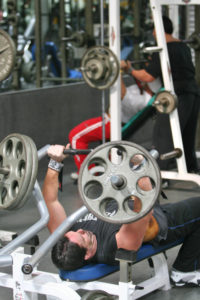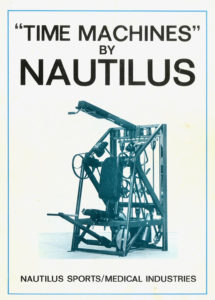 Commonsense advice on selecting the best exercise equipment
Commonsense advice on selecting the best exercise equipment
By Strength Sensei CP
When I design workouts for athletes, I keep training with machines to a minimum. To put a number on it, an athlete should not perform more than 20 percent of their training with exercise machines. Bodybuilders can do more, but too much, and they risk developing structural imbalances that can increase their risk of injuries. With that introduction, let’s move on to what everyone needs to know about machine training.
An appropriate motto for a gym owner is that you don’t buy gym equipment, you invest in gym equipment. Three thousand dollars for a top-of-the-line pec dec – get used to it. If you start adding features such as selectorized weight stacks and chrome plating, expect the numbers on your checks to look like your social security number!
No discussion of exercise equipment would be complete without mentioning Arthur Jones and his Nautilus machines. Or, as he liked to refer to them because they would supposedly shorten how long it took to get a quality workout, “Time Machines.”
Jones popularized the use of shell-shaped pulleys that varied the resistance, but his creativity lead to the development of many unique machines that stressed the body in unique ways. For example, because Jones was a big believer in pre-exhaustion training (where you would perform an isolation exercise immediately followed by a compound exercise), he developed a line of machines that would combine two exercises in one. For example, he attached a high pulley lat pulldown unit to his pullover machine, a leg press machine to his leg press machine, and a shoulder press to his lateral raise machine. Having so few machines reduced the number of people who could train as they would spend so much time on one unit, so many gym owners decided to stick with the single-function units.
 Published in 1973 and inserted in an issue of Iron Magazine, this catalog/mini-book introduced Arthur Jones’s unique machines that combined two exercises in one. (You can download a PDF of this advertising piece at the following address: http://www.arthurjonesexercise.com/NautilusManual/timemachines.pdf)
Published in 1973 and inserted in an issue of Iron Magazine, this catalog/mini-book introduced Arthur Jones’s unique machines that combined two exercises in one. (You can download a PDF of this advertising piece at the following address: http://www.arthurjonesexercise.com/NautilusManual/timemachines.pdf)
When Arthur Jones came out with his first line of Nautilus machines, they were extremely popular with football players because they were quite large. Later, as resistance training became more popular with women, Nautilus came out with a women’s line scaled down to accommodate their smaller frame. Of course, many gyms couldn’t afford both a men’s and women’s line, so the next step was what could be considered a “unisex” line of machines designed that was slightly larger than the women’s line but not a big as the original line.
While Jones was doing his thing, other equipment manufacturers such as Cybex were designing machines that were adjustable to fit a variety of body types. For the leg extension machines, the backrest and the roller pads were adjustable, such that a 5-foot-tall gymnast could use it right after a 6-5 basketball player. And while Jones’s shell-shaped cams offered a creative approach to varying resistance curves to match strength curves, I was especially impressed with the Strive equipment that had multiple weight pegs on the lever arms that allowed the user to individualized the resistance curve.
Unfortunately, many exercise machines are built by designers who do not have a background in biomechanics or those who do not consult those who do. Also, to cut manufacturing costs, compromises are often made, such as designing the machines with fewer parts. Handles that rotate require more parts and are more expensive than fixed handles, likewise with an adjustable backrest versus a fixed backrest. Such compromises also compromise a machine’s function, which explains why many gym members complain that certain machines “just don’t feel right.”
Although I have my favorite manufacturers of gym equipment, nearly every manufacturer has one unique machine that stands above the rest. Although it may be more “aesthetically attractive” to outfit a gym with equipment from one manufacturer, such a practice may not be in the members’ best interests from a functional standpoint. Stick with the same color and purchase the equipment you think is best. And regardless of what machines you purchase, you need to try out a machine to see how it feels.
Oh, and consider that you may think you’re saving money buying leverage machines without weight holders, you still have to buy weight trees, which take up your precious workout space. On this last point, I can’t recall any gym owners telling me they have “just too much space.”
It’s also important to understand that a gym owner puts themselves in legal jeopardy if he or she allows members to use equipment in ways not recommended by the manufacturer. You’re putting yourself in legal jeopardy if you allow such practices as having training partners stand on a leg press machine to adequately challenge the strongest athletes. (Although performing conventional bicep curls in a power rack doesn’t violate any manufacturer warranties, it’s just wrong.)
Next, don’t expect every gym member to know exactly how to use every exercise machine properly. Machines should have warning labels for “pinch points,” and gym staff should ensure that their members are not abusing the equipment. Just as airline staff must teach us how to use a seatbelt, it’s a gym owner’s responsibility to make certain their members don’t do something stupid like adjusting the lever arm on a selectorized machine and inserting the pin at a higher point (a practice that resulted in an expensive litigation when performed on a squat machine).
Machines have their purpose in nearly every strength program. If you own a gym and are considering investing in new equipment, consider these guidelines to ensure you get not just what you want but what you need!
